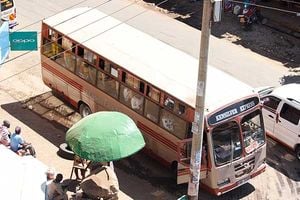Drought watch: Hopelessness as the last of Tana River's water pans dries up

The dry Bulto Abarufa water pan in Galole, Tana River County.
For six years, the Bulto Abarufa water pan supplied the important commodity for more than 30,000 residents in Tana River’s Galole constituency.
The 50 million cubic metre water capacity reservoir served residents during the worst of droughts when the other seven had no water.
But the current sight of one of the county's biggest man-made water reservoirs screams hopelessness.
It is now dry and cracked, with only the water gauge standing at the centre as the aggressive Prosopis Juliflora plant extends its tentacles daily.
"It never occurred to us that we would get here. We have witnessed several seasons of drought that robbed us of a lot, but they never dried this reservoir," said elder Bodha Godhana.
All domestic animals and tens of families are migrating to the Tana Delta in search of water, he said.
The women left behind have to walk 30km to a shallow well in search of water, carrying their children on their backs.
"It is a risk and with the scorching sun coupled with poor feeding, some of the women faint on the road and must be rescued by stronger women," he said.
Asha Athman notes that the journey in search of water has become women's biggest nightmare.
It takes more than three hours to get to the salty well and another three back.
"We take turns in the day. We leave the houses at 5am and return at 1pm, because there is a queue to follow at the well,” she said.

Women line up to fetch water from a shallow well in Bulto Mulitu village in Tana River County.
At the well, nine women line up to help each other draw water. It is a risky human conveyor belt into the 10-foot well that can result in death if one slips.
Back at home, the water undergoes desalination. It must first be boiled to make it consumable for children and cooking.
"Bulto Abarufa rescued us big time. What is left of it is heart-breaking and to us now it is a burden whose end we don’t know. It seems we are fated to suffer," said Ms Athman.
Residents appealed to humanitarian organisations to come to their rescue by supplying water using tankers.
"What we are leaving in the villages now are calves, kids and lambs that need milk that we occasionally buy from the shop and water, which is our biggest problem at the moment,” said Mohammed Kuno.
National Drought Management Authority County Coordinator Abdi Musa notes that there is no water pan left with water across the county.

The now dry 50 million cubic metre water capacity Bulto Abarufa water pan served residents during the worst of droughts when the other seven had no water.
All the 57 water pans have dried up and there is no hope of rain in the county in the near future, he added.
"The weatherman has reported that the rains in our area may not come, and we are already at the alert stage [and] therefore we are preparing for the crisis phase," he said.
Whereas the situation is dire, the county administration will provide water using trucks to the affected areas, said Tana River Governor Dhadho Godhana.
"We have a mega water plant in Bura and we intend to pipe water to these areas. The water crisis in respective areas will not be an issue once that is completed," he said.
He said the plan will be a partnership between the World Bank and the county government and will start anytime in the year.
Meanwhile, the administration has dispatched six water trucks to take water to more than 20 villages in turn, at intervals of four days per village.





